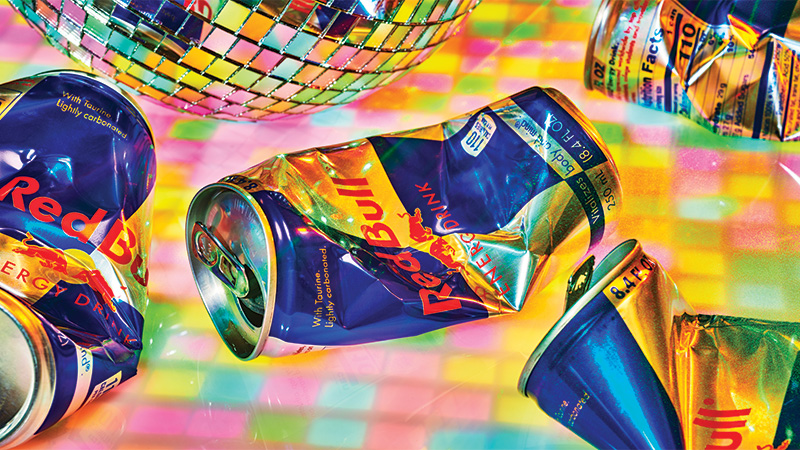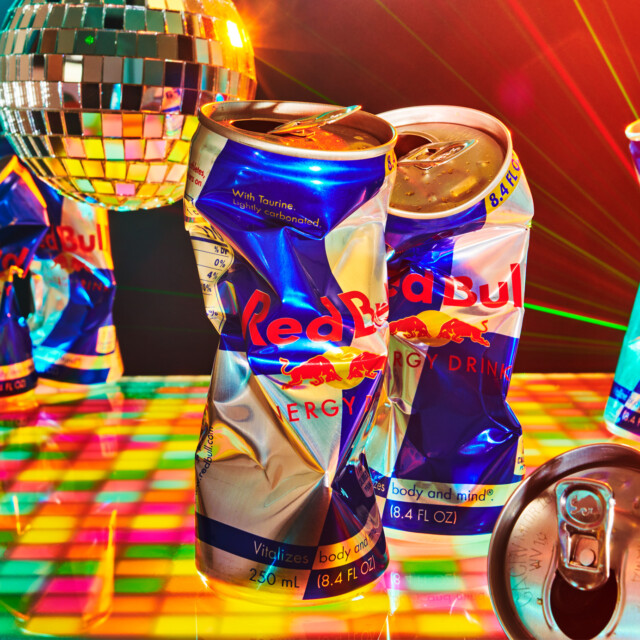In 2021, Red Bull executives visited a San Francisco bar, Butter, where the combination of Red Bull and vodka was allegedly popularized in the ‘90s. The energy drink company had paid for Butter’s owners to create a neon sign stating, “Original Home of the Red Bull Vodka.”
“They said that they are really proud of the relationship,” says Vlad Cood, one of the bar’s owners. “They were just really happy to know that we were one of the original accounts, and we are still here, and we are still doing the same thing.”
The Red Bull brand hasn’t always celebrated use of the drink as a mixer, however, despite Red Bull Vodka — or Vodka Red Bull, as it’s also commonly referred to — becoming a nightlife staple. While the company encouraged people to push themselves to the limit in many aspects of life, when it came to alcohol and the risks associated with it, they appeared a bit more cautious. But the executives’ visit to Butter seems to be part of a change in Red Bull’s attitude toward U.S. drinkers who like to consume the product with liquor.
“They really never wanted to be associated with alcohol and always wanted to be that mind-over-body energy drink for adrenaline and sports,” Cood says.
Wings Hit Turbulence
While Red Bull continues to dominate the energy drink market and saw its revenue increase last year, it isn’t entirely smooth sailing — or flying — for the brand that claims to “Give You Wings.” Red Bull has multiple competitors, including a recently launched energy drink with twice as much caffeine and a caffeinated cocktail that has become the drink of the moment. In July 2020, the company also fired its top North American executives amid allegations of racist insensitivity in its response to the police killing of George Floyd and subsequent Black Lives Matter protests. Further compounding matters, the company’s visionary co-founder, Dietrich Mateschitz, died in October 2022.
“Red Bull’s story is that they are trying to help all of us live our lives to the absolute extreme. They are going to spend a lot of time and a lot of energy, and in some cases, a lot of money, actually living it out.”
By all accounts, the company’s ongoing success boils down to Mateschitz’s original marketing strategy. An Austrian, Mateschitz was working for a German cosmetics company in the early ‘80s and on a trip across Asia when he discovered Krating Daeng, which approximately translates to “red bison” or “red water buffalo.” He connected with its inventor, Chaleo Yoovidhya, and formed a partnership to sell the energy drink around the world, arriving in the United States in 1996.
Mateschitz was also a skier and snowboarder and dreamed of being a free climber, he told The New York Times. While he largely remained on the ground, Mateschitz used extreme sports to convince consumers that Red Bull could help them soar.
In 1987, he persuaded Formula 1 driver Gerhard Berger to walk around holding a bottle of Red Bull, even though he did not have an official endorsement contract, according to “The Self-Made Billionaire Effect: How Extreme Producers Create Massive Value.”
Mateschitz increased his investment in sports, including purchases of Formula 1 racing and multiple soccer teams. The company also sponsored extreme sports such as BASE jumping, mountain biking, and snowboarding. And he launched an event, Red Bull Flugtag, in which competitors try to fly homemade machines over water.
“Red Bull’s story is that they are trying to help all of us live our lives to the absolute extreme,” says Ty Montague, CEO of growth accelerator Co:Collective, who wrote about Red Bull’s business strategy. “They are going to spend a lot of time and a lot of energy, and in some cases, a lot of money, actually living it out.”
Except when it came to pushing the limits while partying, that is.
The Buzz Around Red Bull
Alcohol wasn’t allowed at the raves Vlad Cood threw in the ’90s at Home Base in Oakland, Calif. The events attracted thousands of people, who instead subsisted on other drugs and stimulants. When Red Bull sales representatives got wind, they approached Cood about sponsoring his parties and providing the drink for free. But Cood turned them down because he saw their product as “very synthetic” and “didn’t feel like it was the right place for it.”
Instead, he says, he directed them to give free cases to friends who were opening Butter, “the first D.J. bar in San Francisco.” Meanwhile, Svedka vodka was also trying to establish itself on the U.S. market and provided Butter free product too.
“The unfortunate part is Svedka vodka tasted awful,” Cood says. “It was just like mule ball sweat.”
But a thought occurred to him: Why not combine the mule with a bull? “Red Bull tasted really raunchy as well, but somehow, the horrific vodka and the nasty Red Bull neutralized themselves when they got mixed together,” Cood says. Promoters and D.J.s tried the drink at Butter and then introduced it to other venues around the country.
“Red Bull is about Red Bull, and you either like it or you don’t.”
They likely found a receptive audience because people enjoy liquor when mixed with a stimulant like caffeine, says Cecile Marczinski, a psychologist at Northern Kentucky University who studies the effects of alcohol on humans.
“People will drink more, they will drink faster, they feel less sedated, so the experience is more pleasurable,” Marczinski says, adding that it’s not “surprising that once some people have tried these drinks, they would share that information with other people, and the trend would continue.”
Regulators were not as excited about the combination. In 2010, the Food and Drug Administration issued a warning to four companies selling caffeinated alcoholic drinks because consumption of them could cause “risky behaviors that may lead to hazardous and life-threatening situations.” (Red Bull was not one of them.) A 2010 study in the journal Addictive Behaviors found that bar patrons who consumed alcohol with energy drinks were three times as likely to leave a bar highly intoxicated and four times as likely to drive as compared to people who did not consume alcohol mixed with energy drinks.
One of the four companies, Four Loko, offered what was nicknamed “blackout in a can.” States and colleges banned the drink after reports of children and young adults consuming it and then landing in the hospital or even dying. Shortly after the FDA warning letter, the company announced that it would remove caffeine and other stimulants from the drink.
Red Bull Says Cheers to Alcohol
While the company has avoided promoting Red Bull cocktails in the United States, it has done so in other countries. Around 1996, Ross Chowles’ creative agency, The Jupiter Drawing Room, helped launch Red Bull in South Africa. The company organized a surfing competition, “Red Bull Big Wave Africa,” and contests in which participants used Red Bull cans to make art. But the company’s “brand bible” did not allow the agency to promote the drink in the rave scene, which was also at its height in Cape Town, Chowles says.
If they had tied their fortunes to the rave culture, “they would have died with the rave culture,” says Chowles, who is now a professor in the advertising and public relations department at Michigan State University. Instead, he says, “Red Bull is about Red Bull, and you either like it or you don’t.”

Still, the agency created tent cards for tables at restaurants and bars promoting a partnership between Red Bull and Smirnoff vodka, Chowles says. The company also offered cocktail recipes on website versions targeted at other countries. But in the United States, the company only offers mocktail recipes, and only started doing so in March 2020, according to a Google search.
In other aspects of its operations, the company has started to more explicitly embrace alcohol collaborations. About a year ago, Dock Asian Eatery, a restaurant in the Bushwick neighborhood of Brooklyn, put up a sidewalk sign advertising a Red Bull “tropical tequila” drink as part of a Red Bull marketing campaign, according to the restaurant owner.
And, in Formula One, the Oracle Red Bull Racing team in May entered into its “first-ever official global spirits” partnership with the Bacardi spirits company and its rum, tequila, vodka, and gin brands. It’s unclear what prompted the change in marketing — or which party initiated the relationship.
A Red Bull spokesman declined to answer questions about the company’s approach to alcohol.
Caffeinated Cocktail Causes a Stir
It doesn’t appear that the shift in marketing was motivated by a decrease in sales. The company reports that it sold more than 11 billion cans last year, which raised revenue by 24 percent. But in addition to its longtime competitor Monster, in January 2022, YouTube personalities Logan Paul and KSI launched a beverage brand, Prime, which includes an energy drink with double the amount of caffeine as Red Bull. The founders say their company did $250 million in retail sales in its first year.
Red Bull may also be feeling pressure in the nightlife industry from a fancy competitor: the Espresso Martini, which has dominated cocktail lists over the past year or so. The owner of a disco bar that opened in December 2022 in Los Angeles told The Los Angeles Times that he included the drink on its menu because it “connects cocktail culture and what mainstream people know.”
“Also, Red Bull and vodka sucks,” he added.
Cood, who continues to drink Red Bull daily, doesn’t expect the Red Bull Vodka to become passé.
“The Red Bull Vodka is just integrated into the culture,” Cood says. “As long as Red Bull stays prominent, the Red Bull Vodka won’t go anywhere.”
This story is a part of VP Pro, our free platform and newsletter for drinks industry professionals, covering wine, beer, liquor, and beyond. Sign up for VP Pro now!
